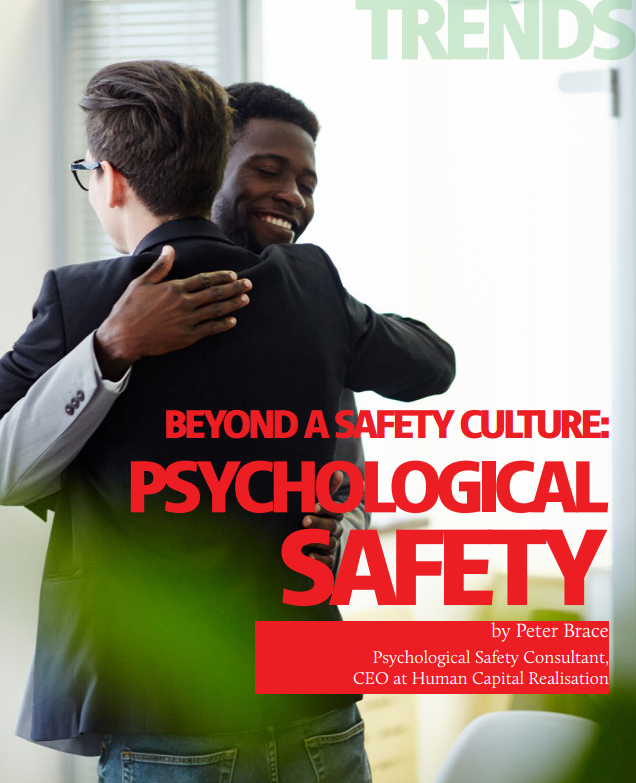Beyond A Safety Culture:
Psychological Safety
By Peter Brace

LINKAGE Q1 (2024) - TRENDS
P
sychological safety seems to be on everyone’s mind these days. At this year’s AMCHAMTT HSSE Conference I was privileged to be able to address it directly—the first time this has happened at the conference. And in this article, we’ll focus mainly on the power of psychological safety to improve all aspects of health and safety in teams and organisations.
Psychological safety is simply the lack of interpersonal fear in a group (Edmondson, 2018). It is the feeling that our team is a safe place to speak up, share ideas, and even challenge the way we work together. We feel safe because, rather than being ignored, or even punished or ridiculed for sharing our thoughts, we expect to be heard and appreciated for bringing our unique perspective to the team.
When psychological safety is high, it brings a wide range of benefits to the team and organisation. But how does it impact physical and mental health and safety?
In organisations today, we tend to try and reduce everything to its component parts, and to try and count, categorise, and control everything. But some things are better considered holistically. And health and safety, despite our best efforts to measure and manage them, are best understood as emerging from the highly complex and unpredictable human environment which is the modern workplace.
The World Health Organisation, for example, suggests that health and well-being need to be considered holistically, as bio-psycho-social. In other words, for us to be safe and healthy, we need to not only care for our physical and mental wellbeing but also the state of our social connections. And health and safety at work is no different from this.
What is Psychosocial Health and Safety?
The psychosocial approach considers the physical and mental wellness of individuals and their ability to function in the context of the combined influence of psychological factors and the surrounding social environment.
Psychosocial hazards are dangers or risks that may cause psychological and physical harm, and arise from
• the design or management of work
• the working environment
• plant at a workplace (for example, equipment, containers, tools, and anything connected to those things)
• workplace interactions or behaviours.
In many jurisdictions, there is now a legal obligation on business leaders to either eliminate or minimize psychosocial risks in the workplace so far as is reasonably practicable. As well as this legal (and moral) obligation, there are compelling business reasons to do so.
In my home country of Australia, workers’ compensation claims related to mental health are set to double by 2030, according to the Economic Development of Australia Report 2022. Australian Bureau Statistics (ABS) workplace data indicates that nearly 15% (1 in 7) of the Australian workers are struggling with mental health problems in the workplace. Workplace stress leads to 3.2 days lost per worker each year, with 25% of the workforce taking time off for this reason. 72% of workers say that stress impacts their physical health and 64% acknowledge it impacts their mental health.

There is an inevitable link to low productivity, poor quality of work, and absenteeism. Pre COVID-19, around 5 million Australians suffered from a mental health condition translating into between 10 and 12 days of sick leave. The Productivity Commission found that this cost $39 billion in lost productivity in 2020. And studies in the EU show, for example, that about a fifth of staff turnover can be related to stress at work, and that among employees who state that they ‘always work under pressure’, the accident rate is about five times higher than that of employees who are ‘never’ subject to pressurized work.
And although physical accidents are far more visible, and usually get more attention than mental health conditions, workers’ compensation mental health claims average 17 weeks of lost time and a median total cost of $27,700 for serious claims, compared to $10,700 for serious physical injury claims. A study by Allianz found that the average cost of a claim with a secondary psychological condition is four times more costly than a primary psychological claim and likely to lead to three times more time off work. This is eight times more time off work than a primary physical injury claim.
From these statistics, it’s clear that psychosocial hazards can cause a lack of engagement, low job satisfaction, and poor productivity, and they all have a strong potential to cause lasting (sometimes permanent) mental and physical harm. And almost all are affected by a COMBINATION of three factors: the work itself, the environment in which the work is done, and—the aspect which is the focus of this article—the social relationships we experience in our everyday work. This combination has been understood for more than 70 years.
Minimizing Psychosocial Hazards Through Psychological Safety
The term ’socio-technical’ was coined in 1951 by Eric Trist, a British social scientist, and Ken Bamforth, a former coal miner. It refers to the understanding that all workplaces are a combination of technology and people. Trist and Bamforth had noticed that under the process of mechanization and standardisation, work had lost its intrinsic meaning. Social relationships at work were now the main source of meaning in the workplace. From these insights came other ideas such as worker participation, picked up by Swedish car makers Volvo and Saab, as well as empowerment, quality circles, teamwork, and many more ideas that today we take for granted.
But it’s also interesting that two of the five principles of designing effective socio-technical systems include having cultures of participation and ensuring empowerment for adaptation (Fischer and Herrmann, 2011). Since the concept of psychological safety was identified in the 1960s, we’ve found that both of these attributes are also seen in workplaces with high psychological safety. And many years of extensive research since then have shown that the level of psychological safety strongly impacts workplace health and well-being.
For example, America’s National Safety Council (NSC), found that those who felt psychologically unsafe in their workplace were 80% more likely to report they had been injured at work, requiring medical attention and/or missed days of work. And workers who believed that their employer discourages reporting (a clear sign of low psychological safety) were 2.4 times more likely to have experienced a work injury.
But why such a major impact? And what can leaders do to make workplaces more psychologically safe, and therefore less mentally and physically hazardous?
When we work with teams to help them improve psychological safety, we focus on five fundamental human needs that relate to how we work in groups, and how these are manifested in workplace teams (Rock, 2009). These needs include:
● A reasonable level of autonomy of how, where and when we perform our work.
● Certainty or predictability in our work—or the confidence that we can deal with a certain level of unpredictability.
● A feeling of belonging to the group; of being included and accepted just the way we are.
● The sense that we, and others in our team, are treated fairly and equitably.
● The feeling that we matter to the group; that regardless of our formal position or title, we are valued and have status.
As these needs are met, psychological safety in the team improves. And psychological safety improves well-being and safety in three ways.
First, it provides increased focus on the team rather than the individual. And this, perhaps counterintuitively, helps the individual to be safer.
For example, many workplaces, even in high-risk industries, get work done through a combination of permanent staff and third-part or independent contractors. They are effectively working on the same team, but contractors may consider their work less secure than the permanent staff, thus they have lower certainty in the team, and they may feel a reduced sense of belonging and lower status. This makes it less likely that they will speak up about a hazard that affects the team, and less likely that they will share their ideas for improving health and safety.
But when we address the psychological safety of a team, we do it with all members, as psychological safety emerges at the level of the team. And this improves the health and safety outcomes for all.
Second, psychological safety improves learning and innovation. And to improve health and safety, and even to maintain it under today’s constantly changing working conditions, you need to have continual improvement of health and safety processes and procedures.
In social systems, like teams, learning is a risky business. It reduces our certainty, exposes us to new ways of working that we have not yet mastered, and (at least temporarily) it threatened our sense of status, increases our risk of failure, and makes us feel we are in danger of ridicule and criticism. But when psychological safety improves, we not only feel safe to learn and try new things, but we also feel safe to share our ideas and support the process of innovation.
Often, the most diverse members of the team are those that have the most innovative viewpoints, but they are also the ones least likely to want to speak up and be seen as different from the rest of the group. But when psychological safety is high, their status is higher, and the team gets the real benefit of diversity when it is accomplished by inclusion or belonging.
Finally, more open communication is a fundamental benefit of greater psychological safety. When there is greater belonging or inclusion, there is safety for all to speak up more freely, and the leader of a psychologically safe team will ensure that all voices are ‘heard’.
For example, they will provide alternative avenues for communication, such as email or anonymous reporting, to those who may be reluctant to approach them personally or to speak up in front of others. And in a workforce that may include the disabled or neurodivergent, this will even include those who are non-speaking.
We only need to take a moment to consider how innovative the disabled among us need to be, just to live and work in a world that is often so full of obstacles for them. More open communication from everyone in the team can provide a massive benefit to the way that the team operates, and it helps to identify those mental and physical hazards that many might miss.
More Than Health and Safety
The focus of this article has been on health and safety, but psychological safety provides even wider benefits than this. Over 50 years of research in almost all types of teams and industries has demonstrated that building psychological safety goes hand in hand with better employee engagement, greater job satisfaction, lower turnover, as well as improved performance (of every Key Performance Indicator that has been examined!).
But the most important benefit is this: A psychologically safe space helps to make a physically and mentally safe space. Leaders have a clear responsibility and a compelling case to pay close attention to the psychological safety of their teams.
Sources
Allianz Australia Insurance Limited, Awareness Into Action - A Holistic Approach To Cultivating Mentally Healthy Workplaces In Australia, 2019
Edmondson, A. The Fearless Organization: Creating Psychological Safety in the Workplace for Learning, Innovation, and Growth. Hoboken, NJ: John Wiley & Sons, 2018
European Risk Observatory Literature Review, Calculating the cost of work-related stress and psychosocial risks. 2014
Fischer G, Herrmann T. Socio-technical Systems: A Meta-design Perspective. International Journal of Sociotechnology and Knowledge Development. 2011;3(1):1-33
Gartner Research, The Missing Element in Nearly Every Learning Strategy
Gallup, State of the American Workforce Report
Herway, Jake. How to Create a Culture of Psychological Safety. https://www.gallup.com/workplace/236198/create-culture-psychological-safety.aspx
Kleiner BM, Hettinger LJ, DeJoy DM, Huang YH, Love PE. Sociotechnical attributes of safe and unsafe work systems. Ergonomics. 2015;58(4):635-49
NSC. “Workers Who Feel Psychologically Safe Less Likely to be Injured at Work”. May 25, 2023. https://www.nsc.org/workplace/safety-topics/psychological-safety-correlates-to-physical-safety
Rock D. Managing with the brain in mind. strategy+business. Autumn 2009;56
Safe Work Australia, Australian Workers' Compensation Statistics 2018-19
Zak, Paul J., “The Neuroscience of Trust,” Harvard Business Review, January 2017
ABOUT THE AUTHOR

Peter Brace is a Psychological Safety Consultant and CEO at Human Capital Realisation.